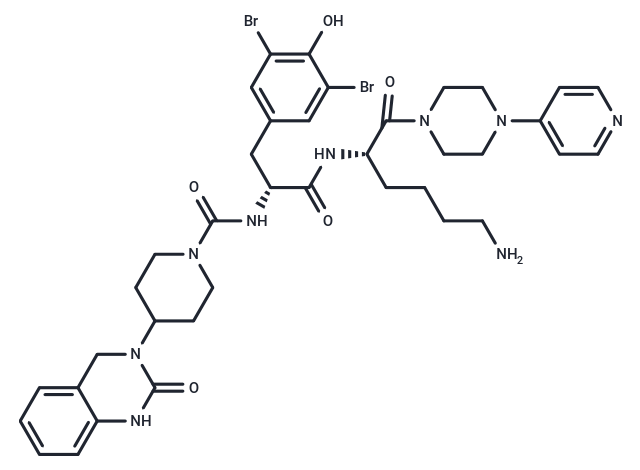Shopping Cart
- Remove All
 Your shopping cart is currently empty
Your shopping cart is currently empty

Olcegepant (BIBN-4096) is an effective and selective non-peptide calcitonin gene-related peptide 1 (CGRP1) receptor antagonist (IC50 of 0.03 nM and Ki of 14.4 pM for human CGRP).

| Pack Size | Price | Availability | Quantity |
|---|---|---|---|
| 1 mg | $31 | In Stock | |
| 2 mg | $47 | In Stock | |
| 5 mg | $97 | In Stock | |
| 10 mg | Inquiry | In Stock | |
| 50 mg | Inquiry | In Stock | |
| 1 mL x 10 mM (in DMSO) | $199 | In Stock |
| Description | Olcegepant (BIBN-4096) is an effective and selective non-peptide calcitonin gene-related peptide 1 (CGRP1) receptor antagonist (IC50 of 0.03 nM and Ki of 14.4 pM for human CGRP). |
| Targets&IC50 | CGRP (human):14.4 pM (ki), CGRP1:0.03 nM |
| In vitro | Olcegepant exhibits exceptional efficacy at primate CGRP receptors, demonstrating a high affinity (Ki) of 14.4±6.3 (n=4) pM for human CGRP receptors, surpassing that of the endogenous ligand CGRP and demonstrating a 150-fold greater affinity than the peptidic antagonist CGRP8-37. It competitively antagonizes CGRP-induced concentration-dependent relaxation, effectively reversing CGRP-mediated vasodilation in human cerebral vessels and inhibiting neurogenic vasodilation in a surrogate animal model for migraine pathophysiology. This suggests that Olcegepant, acting as a CGRP receptor antagonist, may be a potential novel abortive treatment for migraines. Its competitive antagonism has also been confirmed in SK-N-MC cells, with its effects observed in isolated human cerebral, coronary, and omental arteries using sensitive myograph techniques[1][2][3]. |
| In vivo | Pre-treatment with Olcegepant (900 μg/kg) inhibits capsaicin-induced Fos expression in the spinal trigeminal nucleus by 57%, without altering phosphorylated extracellular signal-regulated kinase expression in the trigeminal ganglion. Olcegepant (1-30 μg/kg, i.v.) suppresses CGRP effects on facial blood flow in marmosets and significantly reduces mechanical allodynia in CCI-ION rats (0.3-0.9 mg/kg, i.v.). Additionally, Olcegepant (0.6 mg/kg, i.v.) decreases c-Fos immunolabeled cells and ATF3 transcript upregulation, but not interleukin-6, in the trigeminal ganglion of CCI-ION rats [2][4][5]. |
| Alias | BIBN-4096, BIBN 4096BS |
| Molecular Weight | 869.65 |
| Formula | C38H47Br2N9O5 |
| Cas No. | 204697-65-4 |
| Smiles | O=C1N(CC=2C(N1)=CC=CC2)C3CCN(C(N[C@H](CC4=CC(Br)=C(O)C(Br)=C4)C(N[C@H](C(=O)N5CCN(CC5)C=6C=CN=CC6)CCCCN)=O)=O)CC3 |
| Relative Density. | 1.497 g/cm3 |
| Storage | Powder: -20°C for 3 years | In solvent: -80°C for 1 year | Shipping with blue ice. | |||||||||||||||||||||||||
| Solubility Information | DMSO: 23.81 mg/mL (27.38 mM), Sonication is recommended. | |||||||||||||||||||||||||
Solution Preparation Table | ||||||||||||||||||||||||||
DMSO
| ||||||||||||||||||||||||||

Copyright © 2015-2024 TargetMol Chemicals Inc. All Rights Reserved.